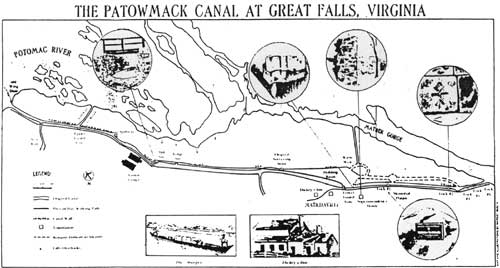|
GEORGE WASHINGTON MEMORIAL PARKWAY
Patowmack Canal and Locks (Great Falls Section) Historic Structures Report — Architectural Data Section |

|
APPENDIX G
United States Department of the Interior
NATIONAL PARK SERVICE
GEORGE WASHINGTON MEMORIAL PARKWAY
C/O TURKEY RUN PARK
McLEAN, VIRGINIA 22101
IN REPLY REFER TO:
H14217
GWMP 300-15
DEC 30 1985
Memorandum
To: Regional Director, National Capital Region
From: Superintendent, George Washington Memorial Parkway
Reference: George Washington Memorial Parkway, Pkg. No. 300, Repair Structural Damage, Patowmack Canal, Great Falls Park
Subject: Memorandum of Decision
We have made the decision to initiate a multi-phase program to preserve the historic resources of the Patowmack Canal at Great Falls Park, Virginia (see attached site map). This decision follows consideration of the N.P.S. document, Patowmack Canal Preservation Alternatives, which was produced and distributed to the public in May 1985. The work program will be the following combination of elements from all three alternatives described and assessed in the preservation alternatives document.
The initial phase of work will include the highest priority elements involving the stabilization and selective restoration of those canal and related structures which are in danger of being lost due to collapse, specifically locks one and two. Preservation techniques for these structures will be determined by investigation of their condition and structure, Lock two may require earth filling due to its major structural failures. Lock one will be provided with stairs and a walkway for visitors to enter the lock.
The second priority will be to protect the historic resources that are subject to slow deterioration and erosion from natural forces and visitor use. Masonry structures will be reset, as necessary, to stabilize them. Vegetation will be cleared away from masonry structures to eliminate the deleterious effects of tree root incursion, both in the canal and in Matildaville. Drainage systems will be installed in the canal and locks to minimize the adverse effects of water by erosion and the freeze/thaw cycle. An interpretive trail will be built which will enable visitors to see and learn about the canal in an informative manner and eliminate the need for visitors to climb unnecessarily over masonry structures.
The resources also will be made more visible and accessible so that visitors may better understand and appreciate the nature of the canal. The canal will be excavated, delineated, and filled with earth to the historic operating level in the section between the grist mill and the holding basin.
Vegetation will be selectively cleared in and adjacent to the canal and Matildaville to enable visitors to appreciate the historic resources. Repairs to the canal during the twentieth century have added elements which are non-historic and these can be confused with the historic resources. These elements will be removed to prevent misinterpretation of the canal. Vegetation outside the canal prism and Matildaville will be managed in a natural manner.
An important element of the preservation program will be the continuation of field research to determine what remains of the canal, how it operated, and what opportunities exist to best preserve all remains and better present the historic resources to visitors. A historic structures report is being prepared to document existing conditions of the canal structures. Further archeological and structural studies will also be accomplished as necessary. The results of the research will allow National Park Service management to make additional decisions regarding preservation and presentation of the resources.
Implementation of the preservation program will include satisfaction of all legislative compliance requirements, particularly Section 106 of the National Historic Preservation Act. The National Park Service will initiate the appropriate consultations to ensure 106 compliance. Ground disturbing construction activities will be monitored by an archeologist, and natural values of the park, including water quality, will be protected during the preservation program. Actions affecting streams or wetlands will include environmental consultations and permits. Future project proposals will also require additional compliance procedures. All preservation work will conform to the standards and methods described in NPS—28.
Canal repairs and improvements in visibility and accessibility will allow the implementation of interpretive programs. These will aid visitors in understanding the extent of the canal system, the difficulty of its construction, and the creative engineering that was necessary to overcome the challenges to building the canal. A new overall canal program for the visitor center and new wayside exhibits will be developed as part of this program.
John F. Byrne
Superintendent
I concur:
Regional Director, National Capital Region
2/19/86

(click on image for a PDF version)
| <<< Previous | <<< Contents>>> | Next >>> |
patowmack_canal_hsr/appg.htm
Last Updated: 17-June-2011